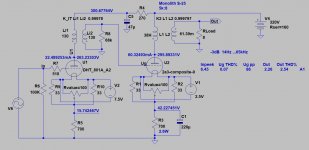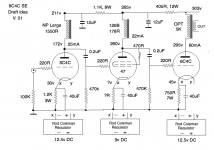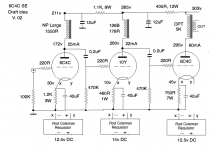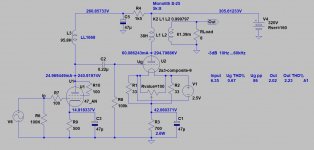I’ve been listening to 3 stage DHT for several years. I‘ll be interested to see what you do. Wish I had the technical knowledge to help. High efficiency speakers are a must…mine are 100 dB.After a week of listening I'm pretty sure that the 6C4C first stage is staying in my system for now. So all new for 2022. This does indeed mean a 3 stage DHT amp, which I've avoided for years, but it looks to be worth it. The first and last stages are 6C4C (or 2a3 outputs) - that much seems settled. So it's now a question of choosing the driver. Contenders are 10Y, 47, 46, maybe 2P29L. Something with at least 15mA through it. I'll put the first 2 stages on one chassis and the outputs in a separate chassis. Not sure how to organise the first 2 stages. I have outboard filament supplies with choke input, and outboard power supplies so I have to choose what goes in the box. The first 2 stages could be direct coupled possibly. I haven't done this with DHTs but since there's no cathode>heater issues and the filament supplies are floating I'm assuming it's straightforward?
Hi - thanks for that. The 2a3 output is the regular 250v, 60mA, -45v.Hi Andy, Calculating of driver gain:
The 2A3 -for example- has 43V bias (B+:300V, 5k:8 OPT, 250V, 50mA op. point).
For reach A1 border (at about 2W output) the first stage must gain more than 15 (2VRMS input).
If you want 3W, the driver gain must be at least 19. Even EML20/30 fulfills this, but another DHT tubes -without SUT- not.
The driver stage is being fed by the 6C4C input stage. So we already have a gain of around mu = 4. Multiply that with a second stage with gain around mu=8 and we get around 32. That's what I have at the moment in my 2 stage amp, so I'm assuming the gain will be OK. How does that sound? A driver stage with a mu = 8? I haven't worked it out in terms of voltages, just gain.
Rod - I will indeed start with the input and driver stages cap coupled. Anything for a simple life. (Did I just say this with a 3 stage DHT amp???)
Last edited:
The later version is more sympathetic. The independent power amp, with appropriate input voltage is more exploitable than which have built-in preamp.
"I don't have any triode curves for the 47."
You mean that Spice model or "printed" curves?
The later -in pentode mode- are in Ale's blog:
https://www.bartola.co.uk/valves/valve-curves/47-pentode/
*
BGG GG 0 V=V(G,K)+0.8142945
BM1 M1 0 V=(0.01977114*(URAMP(V(A,K))+1e-10))**-0.21780976
BM2 M2 0 V=(0.87320496*(URAMP(V(GG)+URAMP(V(A,K))/6.4131375)+1e-10))**1.7178098
BP P 0 V=0.00041486062*(URAMP(V(GG)+URAMP(V(A,K))/7.3443668)+1e-10)**1.5
BIK IK 0 V=U(V(GG))*V(P)+(1-U(V(GG)))*0.00027250508*V(M1)*V(M2)
BIG IG 0 V=0.00020743031*URAMP(V(G,K))*1.5(URAMP(V(G,K))/(URAMP(V(A,K))+URAMP(V(G,K)))*1.2+0.4)
BIAK A K I=URAMP(V(IK,IG)-URAMP(V(IK,IG)-(0.00029498256*URAMP(V(A,K))**1.5)))+1e-10*V(A,K)
BIGK G K I=V(IG)
* CAPS
CGA G A 1.2p
CGK G K 8.6p
CAK A K 13p
.ENDS
"I don't have any triode curves for the 47."
You mean that Spice model or "printed" curves?
The later -in pentode mode- are in Ale's blog:
https://www.bartola.co.uk/valves/valve-curves/47-pentode/
*
- Generic triode model: 47_T_AN
- Copyright 2003--2008 by Ayumi Nakabayashi, All rights reserved.
- Version 3.10, Generated on Fri Mar 11 07:10:18 2016
- Anode
- | Grid
- | | Cathode
- | | |
BGG GG 0 V=V(G,K)+0.8142945
BM1 M1 0 V=(0.01977114*(URAMP(V(A,K))+1e-10))**-0.21780976
BM2 M2 0 V=(0.87320496*(URAMP(V(GG)+URAMP(V(A,K))/6.4131375)+1e-10))**1.7178098
BP P 0 V=0.00041486062*(URAMP(V(GG)+URAMP(V(A,K))/7.3443668)+1e-10)**1.5
BIK IK 0 V=U(V(GG))*V(P)+(1-U(V(GG)))*0.00027250508*V(M1)*V(M2)
BIG IG 0 V=0.00020743031*URAMP(V(G,K))*1.5(URAMP(V(G,K))/(URAMP(V(A,K))+URAMP(V(G,K)))*1.2+0.4)
BIAK A K I=URAMP(V(IK,IG)-URAMP(V(IK,IG)-(0.00029498256*URAMP(V(A,K))**1.5)))+1e-10*V(A,K)
BIGK G K I=V(IG)
* CAPS
CGA G A 1.2p
CGK G K 8.6p
CAK A K 13p
.ENDS
If you want to use 10Y (or 801) with inductive plate load, must to choose at least 100H -primary- inductance and enough large power section input impedance (grid leak resistor//all capacitance at 100kHz), which all together not less than 10k in mainstream audio band...or 10Y as drivers...
BTW #47 (in triode mode) a little bit insensitive than 10Y.
In pentode mode practically unusable with choke load (80k output impedance).
In pentode mode practically unusable with choke load (80k output impedance).
The 3k3 10watt resistor along the top clearly isn't right for creating a 100v drop when passing 15mA to the 2p29l. It needs to be double that value. As proposed, the 2p29l is running much hotter than indicated in the diagram.Here's another way of doing it. Use a 2P29L in the amp and a separate 6C4C preamp.
View attachment 1013324
kind regards
Marek
The 3k3 10watt resistor along the top clearly isn't right for creating a 100v drop when passing 15mA to the 2p29l. It needs to be double that value. As proposed, the 2p29l is running much hotter than indicated in the diagram. kind regards Marek
Yes, as drawn you are correct. I should have added a note that the PSU supplies both R and L channels. So the 3K3 resistor is correct since it feeds the combined 30mA stage. I'm going to see if I can put this stage together today and listen to it, but it won't take long anyway.
The later version is more sympathetic. The independent power amp, with appropriate input voltage is more exploitable than which have built-in preamp.
"I don't have any triode curves for the 47."
You mean that Spice model or "printed" curves? The latter - in pentode mode - are in Ale's blog:
Yes - I want the printed triode curves. I don't use Spice unfortunately.
https://www.diyaudio.com/community/threads/47-penthode-in-triode-mode.64649/Yes - I want the printed triode curves. I don't use Spice unfortunately.
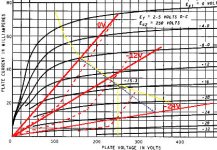
I have - he doesn't have the triode curves anywhere where he can find them at the moment. But we do have his operating point - -15V bias, 230V, 30mAMaybe ask Ale. He measured 47 tubes.
Brilliant! They also agree with Ale's operating point of 215v a-k, 30mA, -15v.
Did you trace the curves yourself?
Did you trace the curves yourself?
- Home
- Amplifiers
- Tubes / Valves
- DHT preamp, 2A3 preamp
